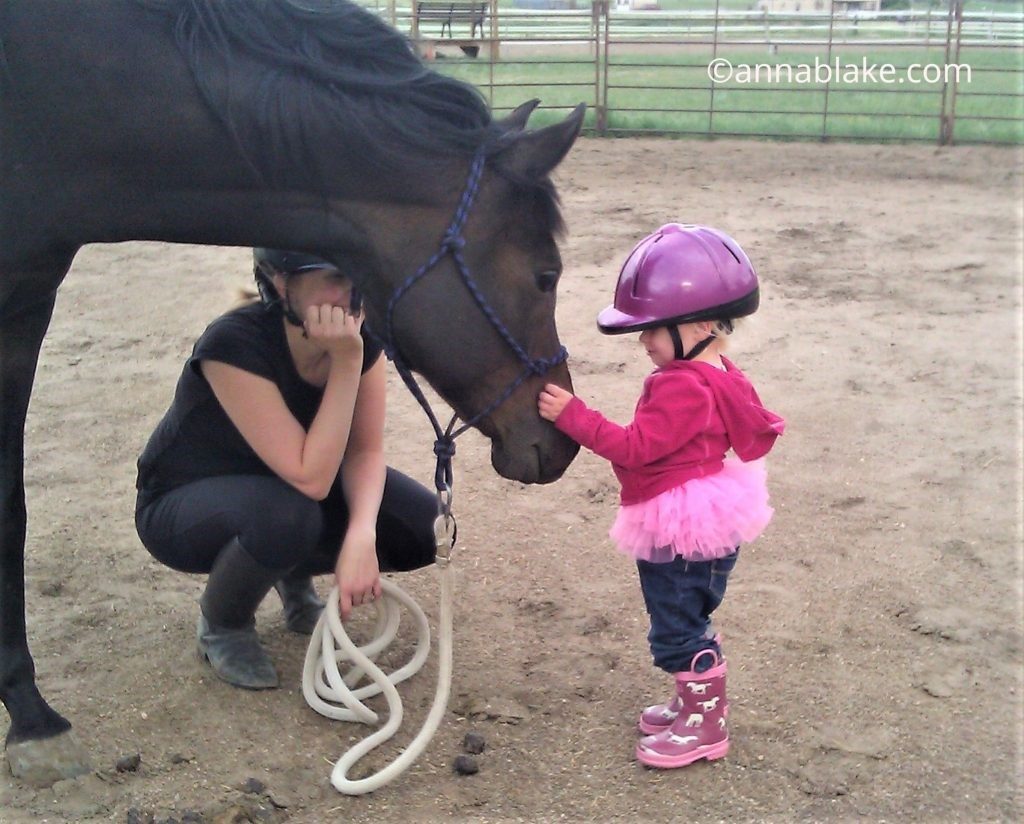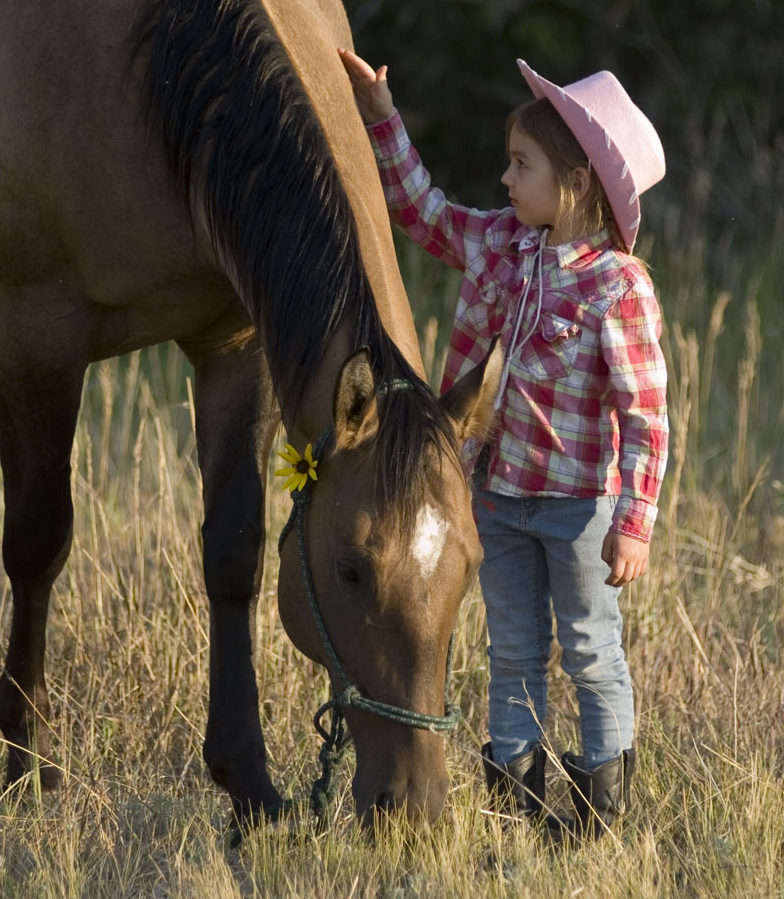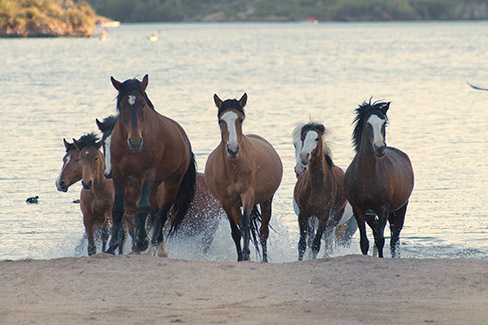Fear, Shame, and Affirmative Training with Horses- Guest Blog by Anna Blake
I started following Anna Blake’s blog months ago. I’ve been enjoying her writings and various Horse stories. Anna was kind enough to allow me to share this blog with my viewers.
Fear with Horses

Courtesy photo-Anna Blake
This is a photo of when you first fell in love with horses. Maybe you dreamed it and it took another fifty years to come true, or maybe you’ve had a horse every day since then. This is also a photo of the first time a horse frightened you a bit. Those two experiences are impossible to separate.
I’m continuing what I started in last week’s essay about losing confidence with a reader’s comment, “When it comes to horses, I think that fear isn’t talked about nearly enough other than in the context of, if you have fear, your horse will know it! I know that I have shame around my horse-based fear and I suspect most others with fear feel the same. I would love to hear more about this topic and how to work with the internal conflict of, “I’m scared,” versus, “I must exude confidence!”
Agreed, if you are afraid, your horse will know. Even if you put on a huge show of bravado, he’ll see through it. Here is a short list of other things he knows: He knows you love him. I don’t believe that horses feel that emotion the same way we do, but a horse can certainly read good intention from us. The proof is their willingness to forgive. The trick is to make your love just an inch bigger than your fear, in a way that makes horse sense.
It helps to understand what’s happening internally. When something startles horses, they move into their flight/sympathetic nervous system. When the dread is eventually released, they come back into the restive/parasympathetic system. It sounds familiar because humans have the same nervous system. When either horses or humans get a fright, we stop breathing normally. Panic follows because breathing is a life or death reflex. With nervous systems like ours, the fear grows fast; it’s like a double runaway but we can come back quickly, too. That’s why breathing is such a strong antidote for both of you.
Here’s the good news. These two aspects of our nervous systems aren’t divided by a narrow line; think of it more as a spectrum. One extreme end is the peaceful parasympathetic end and at the other is horror-filled sympathetic. It’s the spectrum between love and fear, a spectrum all horses and humans exist on. So, your fear is kind of ordinary and normal. Your confidence may feel like it’s deserted you, but it’s not really gone. It’s just sideways from you on the spectrum. I hope that cheers you up a bit.
Life is anxiety; there are no bomb-proof horses or fearless riders. Riders are never in control. Breathe. The best option is to build confidence in our horses and ourselves so when a challenge comes, we cope with it better. Then the more successful experiences we have that our coping skills work, the more trust is shared by both horse and rider. Tada!
Traditional fear-based training methods involve throwing the horse into his sympathetic system by constant correction or intimidation. A horse trained by fear and force becomes unreliable; he sees humans as untrustworthy, too. In affirmative training, the goal is not to keep a horse in his parasympathetic system but start there and begin the ride slowly. When the horse feels a bit of growing anxiety, a step toward his sympathetic end of the spectrum, we slow down and encourage breathing. What if fear was not a failure but common sense asking you to listen and go slow? As the horse soothes himself, he returns to the calm parasympathetic end and he builds confidence by knowing he’s okay. When the rider does the same, a positive tendency of behavior has begun. Eventually, huge challenges seem easy because rather than being flooded by the fear, both are able to slow down and release tension.

I can’t place the phrase, “I must exude confidence!” on the love/fear spectrum between a horse and rider. It’s a third voice; it has the ring of domination training for people. Did a trainer or parent threaten; was it the collective voice of railbirds? Were you punished for being too weak to be cruel enough to frighten your horse? Do you carry a residue of the pain from the break of trust, physical and mental? Your balance might be unreliable with such an unwieldy load to carry. Just like a frightened horse.
One other ordinary thing both horses and humans have is a good memory. We don’t forget bullies or harsh treatment. Maybe the reason we have compassion for abused horses is that we understand how it feels. Now it’s time to show ourselves that same compassion.
Reliving the negativity of abuse leaves a mark on us, energetically. After ranting a while, we have to stop calling ourselves rescues. Exhale, let the story go. Sympathy is a thin comfort and it doesn’t dilute fear. We can’t erase the incident that broke trust, it’s going to stay with all the other fearful experiences and that’s okay. Stop picking the scab, let it go.
Having an awareness of how confidence is lost is also how to welcome it back. Here’s where understanding calming signals changes everything. We can literally communicate with horses, by exchanging calming signals. We have a tool for negotiating the love/fear spectrum.
Honesty with Horses
Begin by going to the arena with your horse and what’s left of your sense of humor. Saying “I’m scared,” is an honest start. Fear shrinks in the face of truth, so drag that monster out into the light. See? He has moist pale skin and he’s the size of a small reptile. Make him watch in the sun with no water. Tell him to wait by the mounting block. With any luck, he’ll get stepped on. I have no sympathy for monsters. I won’t worship fear.
Just walk and breathe. Do some leading from behind. It’s a beautiful day to start a new tendency of riding; to add a positive experience in a new stack next to the stack of less than positive experiences; yay for the opportunity to start over but with better tools this time.
When it feels okay, go to the mounting block and climb to the top step. From this height, it’s easy to see the haters who encourage you to destroy your horse’s trust and try to intimidate you with shame. They’re trying to take horses away from you. Lay a quiet hand on your horse and remember you love him. Smile big. Ignore the voices as an insult. See them pouting? They’ll slink away soon.
You’re still on the mounting block. Your horse is standing quietly, tell him, “Good boy.” He may or may not have his saddle on. It doesn’t matter because your standing at about the height you’d be if you were on his back. Breathe. Remember how much sweeter the air is up here. Remember that little girl. Say an affirmation; mine has always been “I love my horse.”
Does it feel like you might be able to do more? Good. Step down off the mounting block and go back to the barn. Quit when you’re both still hungry. Give that good horse some hay and bring out all the rubber curries. Throw a party because you’re both on the way back.
Training a horse to be a reliable partner is simply the action of collecting a stack of good experiences. In time, with patience for our crazy nervous systems, they add up. Keep breathing, don’t let yourself be spooked by memories. And we all hear those voices, some of us have gotten very strict about which ones we listen to.
You’ll need real courage for this last part. To both you and your horse, offer a cup of forgiveness. Just enough to feel like a light sprinkle of cool rain. Feels good to let go just a bit, doesn’t it?
Relaxed & Forward Training is offering Back in the Saddle, small group, online intensives using personal interaction and videos in this slow confidence-building method with special attention to the horse’s calming signals. Coming in August, contact me with your email address for details.
…
Anna Blake at Infinity Farm
Want more? Join us at The Barn, our online training group with video sharing, audio blogs, live chats with Anna, and so much more. Or go to annablake.com to subscribe for email delivery of this blog, see the Clinic Schedule, or ask a question about the art and science of working with horses.
Working with riders of any discipline and horses of any breed, Anna believes affirmative dressage training principals build a relaxed & forward foundation that crosses over all riding disciplines in the same way that the understanding Calming Signals benefits all equine communication.
Jody L. Miller is a professional photographer specializing in Horse Photography, Equine Photography, and Equestrian photography. Her work can be viewed online here in her gallery section, and she is also featured at these Arizona Galleries: Van Gogh’s Ear Gallery in Prescott, Arizona , The Phippen Art Museum, Hart of AZ Gallery in Old Town Cottonwood and Coops Coffee House at Talking Rock Ranch.

